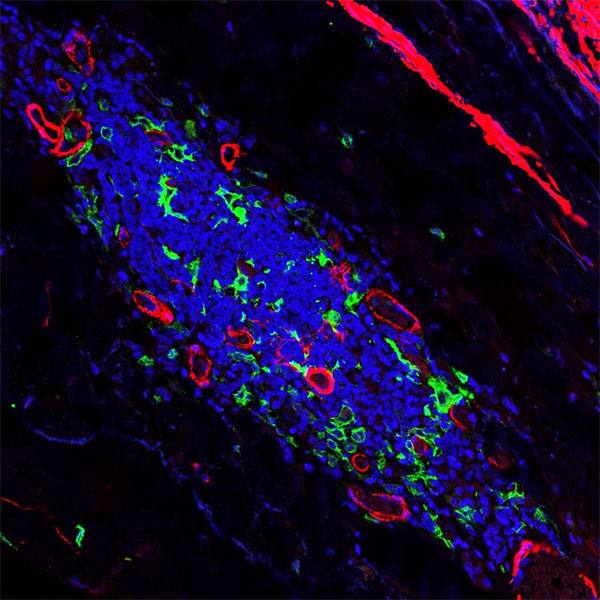-
Science Saturday: Investigating zombie cells and skin aging
When she was just 8 years old, Saranya Wyles, M.D., Ph.D., would recite the stages of wound healing in Latin terms — rubor, tumor, calor, dolor and functio laesa— to her father at the dinner table. Decades later, that ingrained knowledge would be a cornerstone of her regenerative medicine research, education and practice at Mayo Clinic. Dr. Wyles is a Mayo Clinic dermatologist whose subspecialty is regenerative medicine.
"Dermatology has a natural connection to regenerative medicine because the skin is the largest organ that regenerates in the body. There is so much we can learn about regenerative medicine through the skin," says Dr. Wyles. "The unmet needs of patients also drew me to dermatology. I see a lot of age-associated skin conditions and complex inflammatory skin diseases that need treatment beyond the current available treatment armamentarium. I think the new line of cellular (stem cell-based) and acellular (exosome-based) therapies in regenerative medicine have a lot of potential for skin disorders."
Regenerative medicine is an emerging field that seeks to repair, replace or restore diseased cells, tissue or organs. Mayo Clinic's Center for Regenerative Medicine is leading efforts to integrate new regenerative biotherapeutics into clinical care. It supports Dr. Wyles' research as part of its objective of bringing new cures to the practice.
Zombie cells and skin degeneration
A focus of Dr. Wyles' research is the role of zombie cells in skin aging and diseases. Also known as senescent cells, zombie cells secrete harmful proteins and chemicals that become sort of a "toxic soil" locally, if not globally, that disrupts the function of stem cells. When cells become senescent, they no longer divide and differentiate, and they lose their ability to repair diseased tissue — in this case, skin.
"The goal of my laboratory is to understand skin cellular senescence and its role in skin disorders, particularly wound healing and skin fibrosis (scarring)," says Dr. Wyles. "I'm using topical senolytics or topical clearance of senescent cells in preclinical models to investigate whether that can improve wound healing."
Dr. Wyles' dermatology practice addresses rare and complex skin conditions, and her research is aimed at providing new solutions for patients. For example, she is interested in improving treatment for hair loss accompanied by scarring — also known as scarring alopecia.

"The goal of my laboratory is to understand skin cellular senescence and its role in skin disorders."
"Scarring around the hair follicle is poorly understood, and when it happens, it has no regenerative potential. In some cases, senescent cells accumulate around the hair follicle," says Dr. Wyles. "My interest in these types of scarring hair loss is to understand what is driving the thickening and scarring of the tissue and whether new answers lie within regenerative therapies."
Therapeutics to repair aging skin are highly sought after in the cosmetic industry. Dr. Wyles' research seeks to avoid the hype and provide a scientifically validated approach to conditions such as wrinkles, age spots and thinning skin that occur as people grow older. Her studies examine the role of cellular senescence as a biomarker of skin aging.
"My practice and research include the regenerative aesthetic medicine space. Skin appearance is important to many people. If we can find a way to give them clear and healthier skin, it not only boosts their self-esteem, but also their quality of life," says Dr. Wyles. "One of my clinical trials is examining the use of regenerative exosomes that send targeted rejuvenation messages to address skin senescence and aging."
Background in regenerative medicine
The daughter of a pathologist and a biochemist, Dr. Wyles grew up in Chennai, India, before moving to New York City as a teenager. She became intrigued with regenerative medicine during a summer internship as a student at Barnard College/Columbia University. After graduation, she attended the Harvard Stem Cell Institute, where she learned the Nobel prize-winning technology of induced pluripotent stem cells. Those stem cells can be reprogrammed to go back in time to a state where they can be directed to become any type of cell in the body.
"I was always very fascinated with the natural healing potential held within regenerative biotherapeutics. Once I learned that, I wanted to expand my career and see how I could apply it to patient care," says Dr. Wyles.
Drawn to Mayo Clinic by its mission to put the needs of the patient first, Dr. Wyles completed her medical and doctoral degrees in the M.D.-Ph.D program at Mayo Clinic Alix School of Medicine.
A leader in regenerative medicine education
Mayo Clinic is a pioneer in regenerative medicine education, and Dr. Wyles has been one of its biggest champions. She is the director of Mayo Clinic's patient-centered "Regenerative Medicine and Surgery" selective courses that have introduced medical students, graduate students, allied health staff and practicing health care professionals to the promise of regenerative sciences.
In addition, Dr. Wyles is leading an effort to integrate regenerative medicine curricula into all medical schools in Minnesota. Recently, she was named program director for Clinical Regenerative Medicine Education and associate program director for Regenerative Sciences in the Medicine Master's Program at Mayo Clinic.
"I was fortunate to have access to regenerative technologies in their early stage, and I wanted to share that with other trainees. Mayo Clinic is one of the first in the world to develop a medical curriculum for regenerative education, so it's very exciting," says Dr. Wyles.
Just as she was mentored as a young girl by her pathologist father in the steps of wound healing, Dr. Wyles is now helping others learn about regenerative medicine and ways to advance the field. Along with her research, she hopes her roles in education and dermatology will provide new cures for patients with skin diseases.
###








